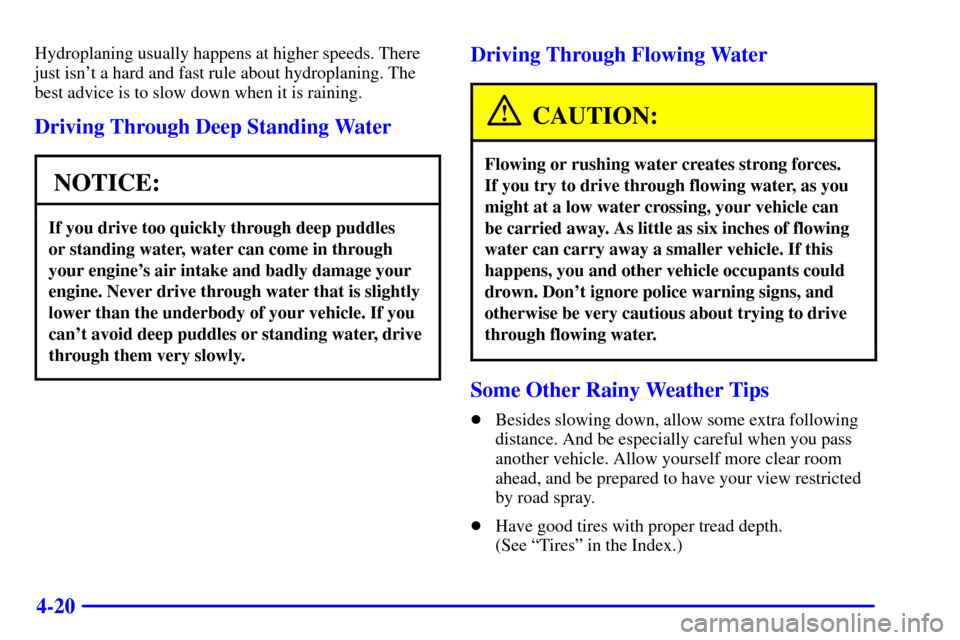Page 141 of 357

2-84 ASR (Acceleration Slip Regulation) System
Warning Light (Option)
This warning light should
come on briefly as you start
the engine. If the warning
light doesn't come on then,
have it fixed so it will be
ready to warn you if
there's a problem.
If it stays on, or comes on when you're driving, there
may be a problem with your ASR system and your vehicle
may need service. When this warning light is on, the system
will not limit wheel spin. Adjust your driving accordingly.
The ASR system warning light will come on if you turn
the system off by pressing the ASR button located on
the console and the warning light will come on and stay
on. To turn the system back on, press the button again.
The warning light should go off. (See ªASR Systemº
in the Index for more information.)
If the ASR system warning light comes on and stays
on for an extended period of time when the system is
turned on, your vehicle needs service.
Low Traction Light
When your anti-lock
system is adjusting brake
pressure to help avoid a
braking skid, this light
will come on.
If you have the ASR system, this light will also come on
when the system is limiting wheel spin. You may feel or
hear the system working, but this is normal. Slippery
road conditions may exist if the low traction light comes
on, so adjust your driving accordingly. The light will
stay on for a few seconds after the ASR system stops
limiting wheel spin.
The low traction light also comes on briefly when you
turn the ignition key to RUN. If the light doesn't come
on then, have it fixed so it will be there to tell you when
the anti
-lock brake system or ASR system is active.
Page 147 of 357

2-90 Low Oil Light
This warning light
should come on briefly
while you are starting your
engine. If the light doesn't
come on, have it repaired.
If the light stays on after starting your engine, your
engine oil level may be too low. You may need to add
oil. See ªEngine Oilº in the Index.
NOTICE:
The oil level monitoring system only checks the
oil level when you are starting your engine. It
does not keep monitoring the level once the
engine is running. Also, the oil level check only
works when the engine has been turned off long
enough for the oil to drain back into the oil pan.
Oil Change Light
This OIL CHANGE light
should come on briefly as
a bulb check when you
start the engine. If the OIL
CHANGE light doesn't
come on, have it serviced.
If the OIL CHANGE light comes on and stays on for
60 seconds after you start the engine, have the oil changed.
For additional information, see ªEngine Oil, When to
Changeº in the Index. After changing the engine oil, the
system must be reset. See ªHow to Reset the Oil Change
Lightº in the Index.
Page 148 of 357
2-91 Service Vehicle Light
This warning light
should come on in your
instrument panel cluster for
a three
-second bulb check
when you first start your
vehicle. If the light doesn't
come on, have it serviced.
This light will stay on steady if you have certain
non
-emission related vehicle problems. These problems
may not be obvious and may affect vehicle performance
or durability. Consult a qualified dealership for
necessary repairs to maintain top vehicle performance.
Check Gages Light
This warning light
will come on briefly
when you start
the engine.
If the light comes on and stays on while you are driving,
check your gages to see if they are in the warning areas.
Hatch Ajar Light
This warning light should
come on in your instrument
panel cluster for a
three
-second bulb check
when you first start your
vehicle. If the light doesn't
come on, have it serviced.
This light will stay on steady if your hatch is open or
ajar and the ignition key is in RUN.
Page 149 of 357

2-92 Fuel Gage
Your fuel gage tells you
about how much fuel
you have left when the
ignition is on.
When the indicator nears E (empty), you still have a
little fuel left, but you should get more soon.
Here are four things that some owners ask about. All
these things are normal and do not indicate that anything
is wrong with the fuel gage.
�At the gas station, the gas pump shuts off before the
gage reads F (full).
�It takes more (or less) fuel to fill up than the gage reads.
For example, the gage reads half full, but it took more
(or less) than half of the tank's capacity to fill it.
�The gage pointer may move while cornering, braking
or speeding up.
�The gage may not indicate E (empty) when the
ignition is turned off.
Low Fuel Light
If your fuel is low, your vehicle's CHECK GAGES light
on your instrument panel cluster will come on.
Reduced Engine Power Light
(V6 Engine Only)
The REDUCED ENG PWR
warning light should come
on in your instrument panel
cluster for a three
-second
bulb check when you first
start your vehicle.
If the light doesn't come on, have it serviced.
If the REDUCED ENG PWR warning light comes on,
a noticeable reduction in the vehicle's performance may
occur. The vehicle may be driven at a reduced speed
while the REDUCED ENG PWR light is on, but
acceleration and speed may be reduced. Anytime this
warning light stays on, the vehicle should be taken to
an authorized Chevrolet dealer as soon as possible for
diagnosis and repair.
Page 184 of 357

4-7
Avoid needless heavy braking. Some people drive in
spurts
-- heavy acceleration followed by heavy
braking
-- rather than keeping pace with traffic.
This is a mistake. Your brakes may not have time to
cool between hard stops. Your brakes will wear out
much faster if you do a lot of heavy braking. If you
keep pace with the traffic and allow realistic following
distances, you will eliminate a lot of unnecessary
braking. That means better braking and longer
brake life.
If your engine ever stops while you're driving, brake
normally but don't pump your brakes. If you do, the
pedal may get harder to push down. If your engine
stops, you will still have some power brake assist. But
you will use it when you brake. Once the power assist is
used up, it may take longer to stop and the brake pedal
will be harder to push.
Anti-Lock Brakes (ABS)
Your vehicle has anti-lock brakes (ABS). ABS is an
advanced electronic braking system that will help
prevent a braking skid.
When you start your engine, or when you begin to
drive away, your anti
-lock brake system will check
itself. You may hear a momentary motor or clicking
noise while this test is going on, and you may even
notice that your brake pedal moves or pulses a little.
This is normal.
United States Canada
If there's a problem with the anti
-lock brake system, this
warning light will stay on. See ªAnti
-Lock Brake
System Warning Lightº in the Index.
Page 187 of 357

4-10
If your vehicle is in cruise control when the ASR
system begins to limit wheel spin, the cruise control will
automatically disengage. When road conditions allow
you to safely use it again, you may re
-engage the
cruise control. (See ªCruise Controlº in the Index.)
When the system is on,
this warning light will
come on to let you know
if there's a problem with
your ASR system. See
ªASR System Warning
Lightº in the Index.
When this warning light is on, the system will not limit
wheel spin. Adjust your driving accordingly.
The ASR system automatically comes on whenever
you start your vehicle. To limit wheel spin, especially
in slippery road conditions, you should always leave the
system on. But you can turn the ASR system off if you
ever need to. (You should turn the system off if your
vehicle ever gets stuck in sand, mud, ice or snow.
See ªRocking Your Vehicleº in the Index.)
To turn the system off,
press the ASR button
located on the
instrument panel.
The ASR system warning light will come on and stay
on. If the ASR system is limiting wheel spin when you
press the button, the warning light will come on
-- but
the system won't turn off right away. It will wait until
there's no longer a current need to limit wheel spin.
You can turn the system back on at any time by
pressing the button again. The ASR system warning
light should go off.
Page 197 of 357

4-20
Hydroplaning usually happens at higher speeds. There
just isn't a hard and fast rule about hydroplaning. The
best advice is to slow down when it is raining.
Driving Through Deep Standing Water
NOTICE:
If you drive too quickly through deep puddles
or standing water, water can come in through
your engine's air intake and badly damage your
engine. Never drive through water that is slightly
lower than the underbody of your vehicle. If you
can't avoid deep puddles or standing water, drive
through them very slowly.
Driving Through Flowing Water
CAUTION:
Flowing or rushing water creates strong forces.
If you try to drive through flowing water, as you
might at a low water crossing, your vehicle can
be carried away. As little as six inches of flowing
water can carry away a smaller vehicle. If this
happens, you and other vehicle occupants could
drown. Don't ignore police warning signs, and
otherwise be very cautious about trying to drive
through flowing water.
Some Other Rainy Weather Tips
�Besides slowing down, allow some extra following
distance. And be especially careful when you pass
another vehicle. Allow yourself more clear room
ahead, and be prepared to have your view restricted
by road spray.
�Have good tires with proper tread depth.
(See ªTiresº in the Index.)
Page 198 of 357
4-21
City Driving
One of the biggest problems with city streets is the
amount of traffic on them. You'll want to watch out for
what the other drivers are doing and pay attention to
traffic signals.Here are ways to increase your safety in city driving:
�Know the best way to get to where you are
going. Get a city map and plan your trip into an
unknown part of the city just as you would for a
cross
-country trip.
�Try to use the freeways that rim and crisscross
most large cities. You'll save time and energy.
(See the next part, ªFreeway Driving.º)
�Treat a green light as a warning signal. A traffic light
is there because the corner is busy enough to need it.
When a light turns green, and just before you start
to move, check both ways for vehicles that have
not cleared the intersection or may be running the
red light.